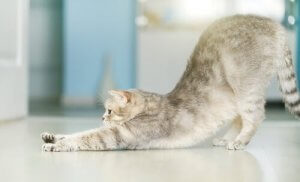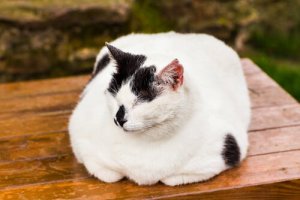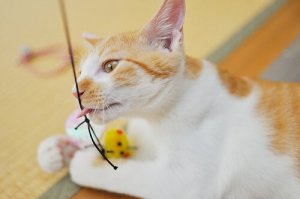How to Help Your Cat Lose Weight

Obesity is by far the most widespread disease among domestic cats. It also comes with a number of associated health conditions, so if you want to have a happy and healthy cat, you need to start by managing their weight. The sedentary lifestyle of pet cats makes them particularly susceptible to weight gain. So, today, we want to show you how you can help your cat lose weight.
Helping your cat to lose weight
Some owners find it difficult to know for sure if their cats are a healthy weight. If you want to find out whether or not your pet is overweight, your vet is the best person to ask. They will be able to tell you the ideal weight for your pet according to its breed, size, and age. It’s best not to try putting your cat on a diet without knowing how long for, and whether it’s actually overweight.
If your vet tells you that your cat is indeed overweight – like the vast majority of the feline population – there are a number of things you can do. While you’ll probably need to make changes to their diet, you’ll also need to encourage them to get more exercise. Just like humans, there are several ways to help your pet reach their ideal weight.

Help your cat lose weight – consult your vet
Before you start making changes to your cat’s diet, it’s important to consult with your vet. In doing so, you’ll be able to determine if your pet’s weight gain is the result of an underlying illness, or a sedentary lifestyle. If your cat is suffering hypothyroidism, for example, switching to diet food won’t help. In fact, it could actually make matters worse.
Making changes to their diet
A sedentary lifestyle and a fatty diet may be the cause of your cat’s weight gain. If this is the case, you’ll need to make changes to their diet to help them slim down. You can buy a number of light foods specially designed for obesity management. However, there are also other options.
Next, you’ll need to take a look at the ingredients in your cat’s usual food. Low-quality cat foods will contain cereals, oils and fats, which can be harmful to your pet’s health. Before switching them on to diet food, you could try to look for a better quality pet food instead. It should be free from oils and fats, and have a higher content of pure meat or fish.
In fact, low-fat natural food – or the BARF diet – can also help. Making your cat’s food yourself means you can be certain it’s only eating high-quality, low-fat foods.
On the other hand, it’s important to keep a close eye on the portion sizes – there’s no point in feeding your cat low calorie, natural food if you continue to give them more than they need. Daily food requirements are usually specified on the back of the packet, so be sure to follow these guidelines carefully.
It can also be helpful to divide their daily allowance into several smaller portions. Four small meals a day is better than one large one.
Find new ways to feed your pet
You can also help your cat lose weight by changing the way you feed them. Look for ways to encourage them to do exercise. For example, you could try changing where you place their food bowls.
One option might be to put the bowls up on the table. That way, your cat will have to put aside its laziness, and climb up and down from the table several times a day if it wants to eat. This will be valuable exercise for your pet.
Help your cat lose weight with exercise
Just like in humans, obesity isn’t just caused by a poor diet. Exercise is essential for any animal, but especially for those that need to lose weight.
You can encourage your cat to be more active by playing with it regularly. A couple of minutes of playtime every day can be enough to make a difference. Make them chase feathers, a toy mouse or a wind-up bug. Cats love to hunt, and they need to use every muscle in their body if they want to catch their prey.
You could also make some small changes to their home environment to get them to be more active. As everyone knows, cats love being up high. With this in mind, you could by a large climbing frame to encourage them to jump on and off.
Some people even go so far as to put up shelves and walkways along the walls so that their cats spend all day climbing up and down.

Be careful not to force your cat to do to much. Animals that are very overweight are prone to joint pain, so it’s important not too push them too hard. Your cat is likely to be very unfit, and their joints may be under severe pressure from supporting all that extra weight.
As we’ve already mentioned, the first step is always to consult with your vet. They will be able to give you help and advice on the kind of exercise your pet can do without causing them pain.
Neutering myths
Many people believe the myth that neutering cats causes them to gain weight. However, this isn’t exactly true. Statistics show that 60% of domestic cats are overweight, and 41% of these overweight cats are neutered. This means that less than half of neutered cats are fat, and there are far more overweight cats than there are neutered ones.
That said, neutering can lower a cat’s metabolic rate. It can also make them lazier and less active. However, this varies depending on the individual cat. Many maintain a stable weight after they’ve been neutered.
In any case, if your neutered cat is overweight, you don’t just have to accept it. Their excess weight is more likely to be due to a sedentary lifestyle than to the fact that they’re neutered.
Maintaining an ideal weight isn’t a question of aesthetics. It’s a question of health. An obese cat will be prone to a number of other diseases, and will have a noticeably shorter lifespan. As a general rule, a slim cat is a healthy cat. It’s vital that you help your pet lose weight before it develops any other health complications.
Obesity is by far the most widespread disease among domestic cats. It also comes with a number of associated health conditions, so if you want to have a happy and healthy cat, you need to start by managing their weight. The sedentary lifestyle of pet cats makes them particularly susceptible to weight gain. So, today, we want to show you how you can help your cat lose weight.
Helping your cat to lose weight
Some owners find it difficult to know for sure if their cats are a healthy weight. If you want to find out whether or not your pet is overweight, your vet is the best person to ask. They will be able to tell you the ideal weight for your pet according to its breed, size, and age. It’s best not to try putting your cat on a diet without knowing how long for, and whether it’s actually overweight.
If your vet tells you that your cat is indeed overweight – like the vast majority of the feline population – there are a number of things you can do. While you’ll probably need to make changes to their diet, you’ll also need to encourage them to get more exercise. Just like humans, there are several ways to help your pet reach their ideal weight.

Help your cat lose weight – consult your vet
Before you start making changes to your cat’s diet, it’s important to consult with your vet. In doing so, you’ll be able to determine if your pet’s weight gain is the result of an underlying illness, or a sedentary lifestyle. If your cat is suffering hypothyroidism, for example, switching to diet food won’t help. In fact, it could actually make matters worse.
Making changes to their diet
A sedentary lifestyle and a fatty diet may be the cause of your cat’s weight gain. If this is the case, you’ll need to make changes to their diet to help them slim down. You can buy a number of light foods specially designed for obesity management. However, there are also other options.
Next, you’ll need to take a look at the ingredients in your cat’s usual food. Low-quality cat foods will contain cereals, oils and fats, which can be harmful to your pet’s health. Before switching them on to diet food, you could try to look for a better quality pet food instead. It should be free from oils and fats, and have a higher content of pure meat or fish.
In fact, low-fat natural food – or the BARF diet – can also help. Making your cat’s food yourself means you can be certain it’s only eating high-quality, low-fat foods.
On the other hand, it’s important to keep a close eye on the portion sizes – there’s no point in feeding your cat low calorie, natural food if you continue to give them more than they need. Daily food requirements are usually specified on the back of the packet, so be sure to follow these guidelines carefully.
It can also be helpful to divide their daily allowance into several smaller portions. Four small meals a day is better than one large one.
Find new ways to feed your pet
You can also help your cat lose weight by changing the way you feed them. Look for ways to encourage them to do exercise. For example, you could try changing where you place their food bowls.
One option might be to put the bowls up on the table. That way, your cat will have to put aside its laziness, and climb up and down from the table several times a day if it wants to eat. This will be valuable exercise for your pet.
Help your cat lose weight with exercise
Just like in humans, obesity isn’t just caused by a poor diet. Exercise is essential for any animal, but especially for those that need to lose weight.
You can encourage your cat to be more active by playing with it regularly. A couple of minutes of playtime every day can be enough to make a difference. Make them chase feathers, a toy mouse or a wind-up bug. Cats love to hunt, and they need to use every muscle in their body if they want to catch their prey.
You could also make some small changes to their home environment to get them to be more active. As everyone knows, cats love being up high. With this in mind, you could by a large climbing frame to encourage them to jump on and off.
Some people even go so far as to put up shelves and walkways along the walls so that their cats spend all day climbing up and down.

Be careful not to force your cat to do to much. Animals that are very overweight are prone to joint pain, so it’s important not too push them too hard. Your cat is likely to be very unfit, and their joints may be under severe pressure from supporting all that extra weight.
As we’ve already mentioned, the first step is always to consult with your vet. They will be able to give you help and advice on the kind of exercise your pet can do without causing them pain.
Neutering myths
Many people believe the myth that neutering cats causes them to gain weight. However, this isn’t exactly true. Statistics show that 60% of domestic cats are overweight, and 41% of these overweight cats are neutered. This means that less than half of neutered cats are fat, and there are far more overweight cats than there are neutered ones.
That said, neutering can lower a cat’s metabolic rate. It can also make them lazier and less active. However, this varies depending on the individual cat. Many maintain a stable weight after they’ve been neutered.
In any case, if your neutered cat is overweight, you don’t just have to accept it. Their excess weight is more likely to be due to a sedentary lifestyle than to the fact that they’re neutered.
Maintaining an ideal weight isn’t a question of aesthetics. It’s a question of health. An obese cat will be prone to a number of other diseases, and will have a noticeably shorter lifespan. As a general rule, a slim cat is a healthy cat. It’s vital that you help your pet lose weight before it develops any other health complications.
This text is provided for informational purposes only and does not replace consultation with a professional. If in doubt, consult your specialist.








